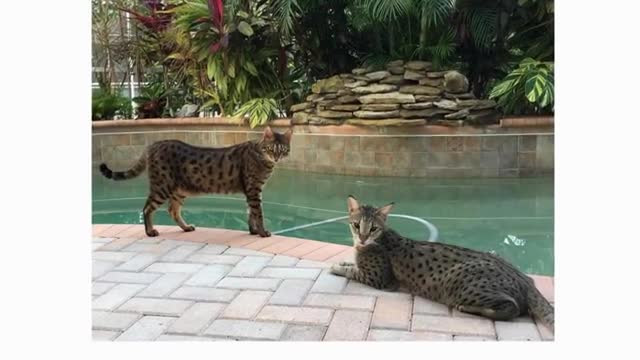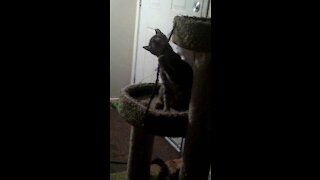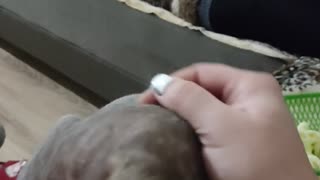Premium Only Content

Savannah Cat 101 : Breed & Personality
n today's video, we are going to talk about a wild breed, that caught the eyes of many cat fanciers around the world.
The Savannah Cat.
Judging by the Savannah Cat’s wild appearance and personality, you might assume that breeders simply plucked a feline right off the plains of Africa. And to be honest, the history of this breed isn’t too far off.
Back in the mid-1980s, a cat breeder in the United States, Judee Frank, had taken into her care a Serval cat named Ernie. To Judee’s surprise, one of her other cats, a Siamese, had a single kitten by Ernie. This first known F1 kitten took the name “Miracle”.
Miracle’s Owners changed her name to Savannah, perhaps to reflect the African savannah heritage, and so began a new cat breed. Much of the Savannahs’ early breeding is credited to Joyce Sroufe and Patrick Kelley, who established the breed by 1996. Shortly thereafter, they submitted the breed standard to the International Cat Association. The Association then formally recognized the cat breed in 2012.
However, other than the specific breeding lines, there is much to be said about the history of the Savannah Cat. With this in mind, let’s take it back to where it all started, a few thousand years ago in Africa.
As early as 1300 BCE, humans traded Serval cats in Ancient Egypt, along with other exotic animals. They appear in Egyptian art depicting mythologies and legends, which suggest that they held a special place in the hearts and minds of Ancient Egyptians.
If you want something even wilder than a Bengal, the Savannah is a cross between a domestic cat and an African serval. First-generation Savannah cats are 50% wild.
It’s no surprise that a Savannah Cat doesn’t display domesticated cat personality traits. You probably won’t find them snuggling up on their Owner’s lap, or waiting patiently for food or treats. Instead, this is a cat with a personality that allowed them to thrive for thousands of years in the African plains.
The most obvious example of this is with the Savannah’s hunting drive. And to understand it, let’s loop back to the Serval. Several adaptations make the Serval an excellent hunter. This wildcat has larger ears than other felines for better hearing. They’re sometimes called “giraffe cats” because, out of all felines, they have the longest legs in proportion to their bodies.
Savannah Cats are curious about new people, which can be off-putting for some. If you’re expecting company, it’s best to warn any newcomers that your wild-looking Savannah Cat will likely approach them, sniff them, and maybe even try to play.
Savannah Cats have a wide range of fascinating vocalizations. From their domestic lineage, you will hear the familiar meowing and purring from Savannahs. But there are a few more surprises, too.
Many Owners report distinctive wailing, yowling, yelping, and chirping. There’s even some characteristic chattering and barking.
This isn’t a cat for every Cat Owner. Unfortunately, some are so enchanted by the Savannah Cat’s unique appearance that they don’t learn more before bringing one home. What’s more, these cats are so rare that it’s not common to spend time with one before making the choice to adopt one.
In reality, though, the Savannah Cat requires more attention, more exercise, more rules, and a more strict diet than other domestic cats. Every cat breed will require good ownership practices, of course. But the Savannah Cat is what you might call a high maintenance breed in comparison.
That said, for those who have experience with high energy cats, and are willing to put in the time and effort, the Savannah Cat is just as enchanting and awe-inspiring as you would expect. With their dog-like qualities and feline grace, this is a breed that is amazing to have around.
-
 0:37
0:37
SavannahCatMan
3 years agoSavannah Cat Fishing
147 -
 4:01
4:01
spatton
3 years ago $0.02 earnedSavannah cat vs. snake
274 -
 0:26
0:26
inknfishn
4 years agoSavannah cat
37 -
 0:20
0:20
Swordplay
3 years agoSavannah Cat on Walk
69 -
 1:04
1:04
Schayes76
3 years agoF2 Savannah Cat Thanksgiving String Dance
233 -
 0:33
0:33
rumblestaff
3 years agoPlaytime With A Savannah Cat Is Both Thrilling And Adorable
3.07K5 -
 1:09
1:09
Burevestnik
4 years agomy beloved cat Marquis, Sphynx breed velvet, I love him
32 -
 9:26
9:26
Dr. Nick Zyrowski
14 hours agoAnti Inflammatory Foods | You MUST Eat These!
27.4K6 -
 15:40
15:40
Bearing
9 hours agoEnd Stage Trump Derangement | Rosie O'Donnell is NOT Doing Well 😬
27.3K179 -
 35:19
35:19
hickok45
12 hours agoSunday Shoot-a-Round # 256
30.5K31